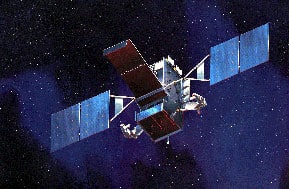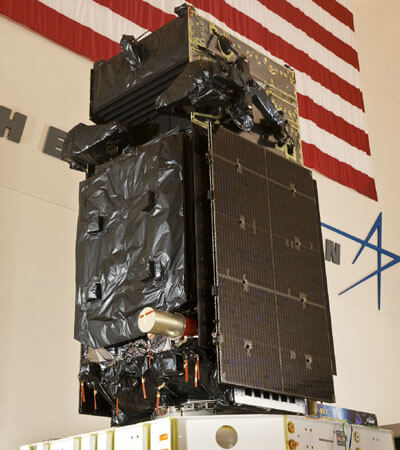The US is updating a space defense system that will warn against ballistic missiles, so that it will be possible to launch an interceptor missile against the attacking missile even before the threat is picked up by the interceptor battery's radar

Amber dew Galileo
For over 40 years the United States has been operating an array of satellites designed to detect the launch of ballistic missiles. These satellites are called DSP (Defense Support Program) satellites, and for readers who remember the first Gulf War (1991) these are the satellites that made it possible to activate the alarms in Israel before the Iraqi missiles landed on our territory.
The original purpose of the DSP satellites was to warn of a ballistic missile attack from the Soviet Union and China. Let's also mention that most of the ballistic missile's flight takes place outside the atmosphere, and hence satellite tracking has an advantage over systems operated by radar.
The array of warning satellites of the United States was becoming obsolete, along with impressive technological developments in the field of electro-optical detectors and computer systems. Due to the combination of these factors, the United States began several years ago to develop a satellite array designed to replace the DSP array.
The alternative system was called SBIRS: Space Based Infra Red System. The new satellite array is divided into two: satellites in low orbit (called LEO: Low Earth Orbit) and satellites in geostationary orbit (at an altitude of 36,000 km). The new satellite array will be able to provide alerts on ballistic missile launches launched in a targeted area and even short-range heavy missiles and rockets. The low-orbit satellites were previously called SBIRS-Low and now the name of the array has been changed to STSS (the acronym for Space Tracking and Surveillance System).
Changes out of necessity
The array of new satellites of the United States received a very important boost last April, with the successful launch into space of the first SBIRS satellite placed in geostationary orbit. This satellite is supposed to be joined by two additional high-orbit satellites, as well as two special electro-optical probes.
The satellites will be installed on classified satellites of the United States, which will travel in highly elliptical orbits (HEO: Highly Elliptic Orbit), which provide a high vantage point that is somewhat similar to a geosynchronous orbit for a significant part of the time.
The array also includes the satellites located in low orbits, a supporting ground array with reception and processing stations, deployed equipment that will be placed at various sites around the world as needed, and an advanced communications array. The cost of the total array is slightly more than 15 billion dollars: the cost of a single SBIRS satellite is about 1.3 billion dollars.
Some changes in the geo-strategic arena exacerbated the American necessity in deploying the new warning system. The USA has political difficulties (mainly due to Russia's opposition) in placing anti-missile warning radar arrays in Europe, the map of threats to the United States and its targets in the world has expanded, in the sense of new players equipped with ballistic missiles (for example, North Korea and Iran), as well as the establishment of an array of interceptors (missiles against missiles) that needs guidance from external sources of information. We note that the US warning satellite array plans suffer from a significant delay in development as well as in placing them in space.
From Iran to Israel in 7 minutes
Naturally, the published information about the space warning systems of the United States against missile launches is limited and limited. However, the open information published so far allows for a professional analysis of certain capabilities of the system, and to determine that the warning capability of the integrated array is extremely high and reliable against a wide variety of threats, starting from the moment of launch until close to the time the missiles hit their target (a missile flight between the United States and Russia takes about half an hour, and from Iran to Israel about seven minutes.
Although the exact figure is classified, it can be assumed that the satellite will send a warning a few seconds after the launch of the missile). Continuous tracking of this kind is innovative and extremely important for dramatically improving the effectiveness of active defense systems (anti-missile missiles, and in the future even laser systems) against the threat.
The United States has officially published the goals of the SBIRS space tracking system, and these are: warning against the launch of intercontinental ballistic missiles (from land-based launchers and submarines), accurate tracking of the attacking missiles - from the moment of launch until they re-enter the atmosphere, distinguishing between the penetration bodies (the warhead of the missile) and between fragments, and fraudulent and deceptive means of various kinds, creating a situational picture, and producing technical intelligence - producing technical information about the performance of the missile by tracking a missile that is in the experimental stages.

After the detection of a missile launch, the system will produce a lot of information that will be transmitted to all the forces involved in providing a solution to the interception of the missile. The information will include the identification of the attacking missile, the exact reference of the launch point and the estimated impact point, data on the direction of flight of the attacking missile and the precise time required to synchronize all the systems. No official announcement has been made about additional information that the satellites are likely to pass on to their operators.
In order to cover the entire surface of the earth with observation, it is possible to be satisfied with three satellites in geostationary orbit placed every 120 degrees of longitude. Given a suitable budget, it is possible to expand this array and allow a stereoscopic observation of a ballistic missile in flight.
The SBIRS satellites are built by Lockheed Martin, and their weight at launch is 4,833 kg. Their weight in orbit, after using a lot of fuel needed for their maneuvers in space, is 2,547 kg. The METAD (detection and tracking system) weighs 450 kg. We emphasize that the first satellite launched in April 2011 was first placed over the United States for the purpose of testing and calibrating its systems. Its final location, and hence its terrestrial footprint, has not been announced. The satellite has a planned lifetime of 12 years.
The heart of the satellite is the array of detectors installed in it and it includes a pair of electro-optical units, one mechanically scanning and the other "staring". The manufacturer of the sensors is Northrop Grumman, who reported that there are about a million (!) pixels on the focal planes of the sensors. The sensors operate in the infrared (IR) range, in the short range (similar to the existing DSP satellite array) and in the medium range. There is a third frequency range, the exact nature of which has not been published, which will allow a deeper look into the atmosphere and track the final flight phase of the ballistic missiles.
Accurate and fast information
One of the most important aspects of the United States' new detection and warning system is the ability to transmit accurate information about the trajectory of attacking ballistic missiles to defense batteries placed in different places, which will allow an interceptor missile to be launched against an attacking missile even before the threat is picked up by the interceptor battery's radar! This is a new and revolutionary capability, which will dramatically improve the ability of active defense systems to deal with various ballistic threats.
We did not discuss here the STSS array satellites, detection and launch tracking satellites placed in low orbits. In conclusion, the warning system against the launch of ballistic missiles is currently facing difficult challenges, due to the expansion of the distribution of ballistic missiles and heavy rockets in many parts of the world. Extending the warning time from this, and providing innovative interception solutions from this, will advance the ability of active defense systems to fulfill their purpose - protecting civilians, strategic targets and military forces around the world.
Tal Inbar is the head of the Center for Space Research, the Fisher Institute for Strategic Air and Space Research, and the chairman of the Israel Space Association.

5 תגובות
The truth is that I got to see this system in real time, I served in the Arrow formation, it's just amazing.
This system works in full cooperation of the entire air defense system of the IDF and provides significant early warning. Although it is not the only one, we have other detection and warning systems.
Abbreviation of designated payloads - that is, the satellite or the other payload on the missile
Are you confused?
It's nice that they also took care of camouflaging the satellite. (looks like an old window air conditioner)
a question.
If the trajectory of the ballistic missiles passes through outer space, is it not possible to eliminate them with the help of a laser from satellites at a much lower power than the terrestrial laser which is limited by clouds and dust and atmosphere?